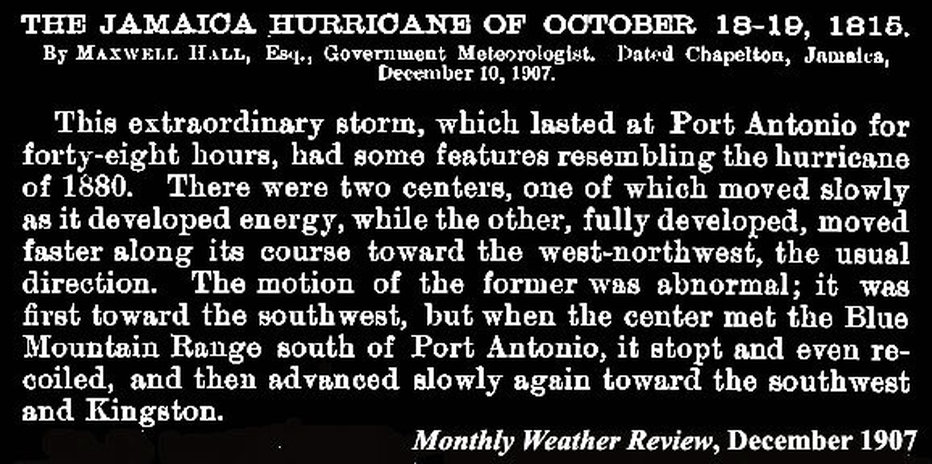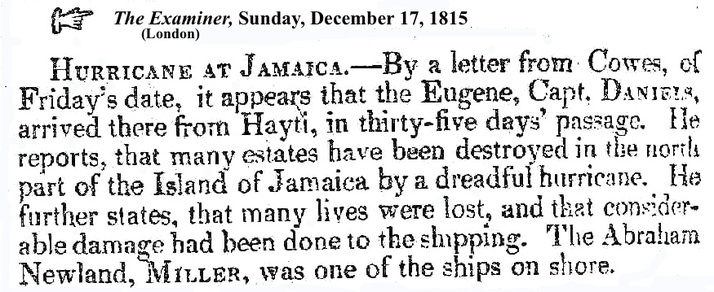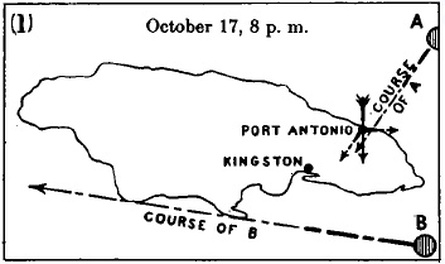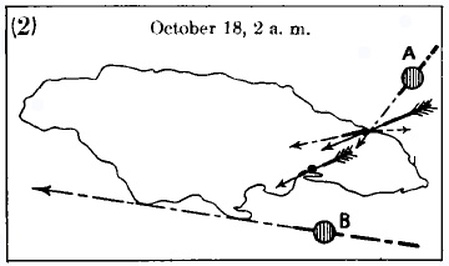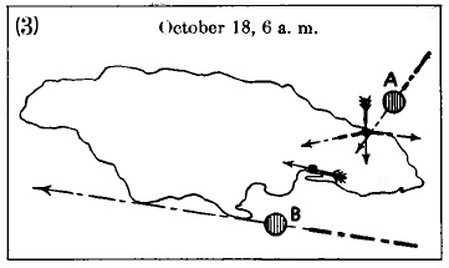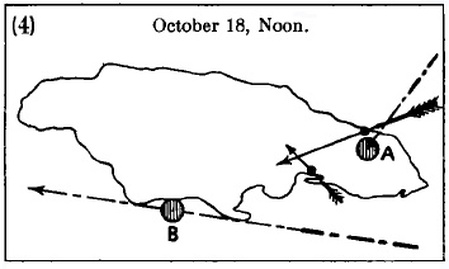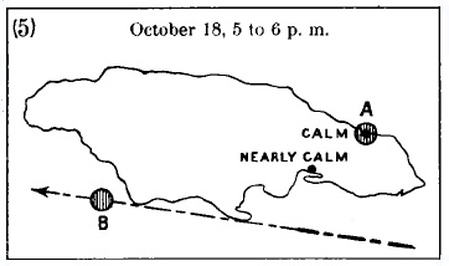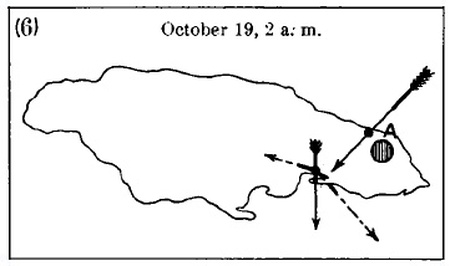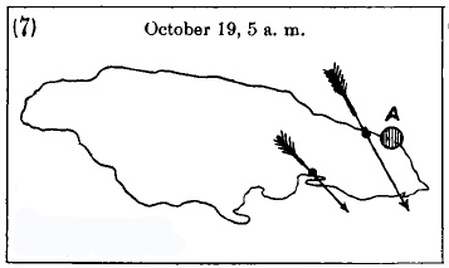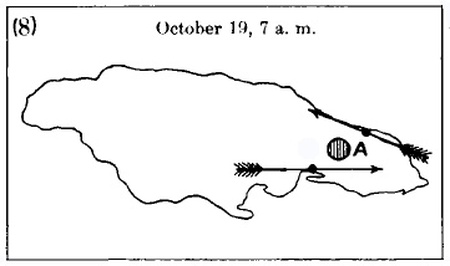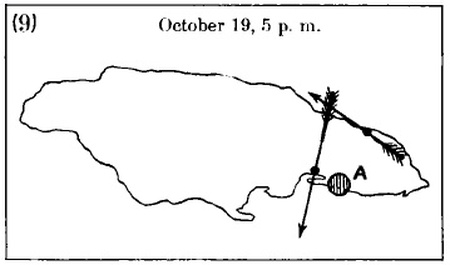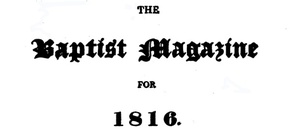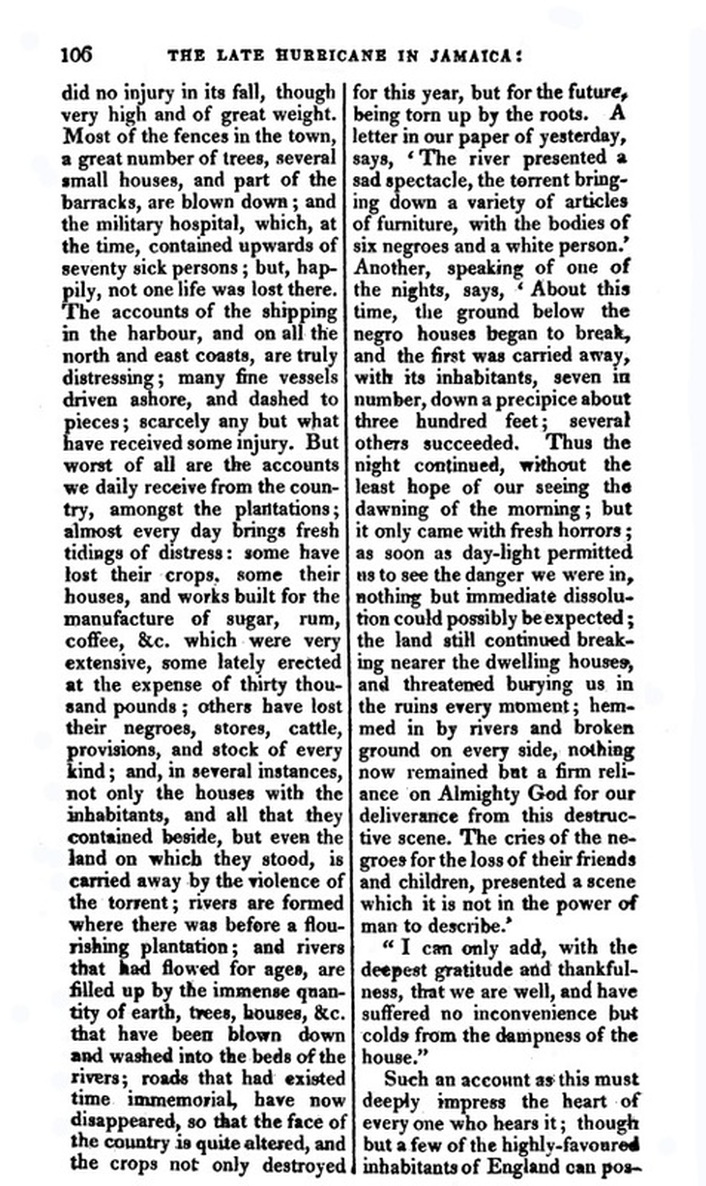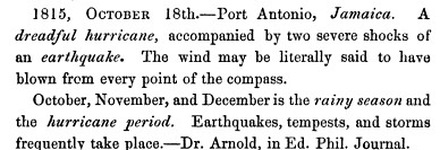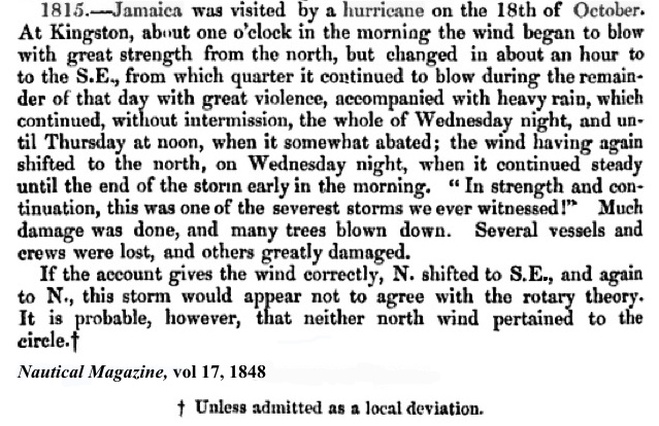October 17-19, 1815
The hurricane of October 1815 is frequently mentioned in general 19th century historical accounts as having been particularly severe. One interesting co-incidence is the catastrophic eruption of the volcano Tambora in Indonesia in April of 1815. It is widely recorded that the eruption had a serious impact on global climate for several years after 1815; it is probably unlikely that the Jamaican hurricane had any link to the eruption - but 1816 came to be known as 'the year without a summer' because of the eruption's impact on temperatures world-wide.
The hurricane viewed from Kingston:
Extract from the Royal Gazette.
KINGSTON, Oct. 21st, 1815
[From Saturday October 14, to Saturday October 21.]
SEVERE STORM.
On Tuesday, Oct. 17th, during the afternoon a heavy fall of rain set in, with a fair prospect of good October seasons; but about two o’clock on Wednesday morning it began to blow extremely hard from the eastward, from whence it changed to the SE; and on the following day it shifted to different quarter of the compass, from N to NW and W, and thence to N, from whence it blew a perfect hurricane from about five o'clock in the afternoon, and throughout the night, accompanied with heavy rain. Yesterday the weather moderated considerably, but during last night a strong breeze prevailed, which, however, lulled early this morning. Great damage has been done in all parts of the city, and almost all the wharves have suffered considerably * * *. At Up-Park Camp the new hospital at the west wing, 185 feet in length, occupied by the 18th Regiment of Foot, was completely thrown down about two o'clock on Thursday * * *. The old officers' quarters were likewise levelled to the ground, and the well-framed roof completely upset. At Stony Hill, we learn, the two northern barracks are completely uprooted, and the other buildings greatly injured * * *. The north wind occasioned a very heavy sea in Port Royal harbour; * * * in the town of Port Royal the gale was very severely felt: most of the old walls standing after the fire have been tumbled down, and the houses that remained after that calamity, as also others that have since been built, received much injury * * *. Not one of the mails from the country had arrived at the General Post Office when this paper went to press.
[Maxwell Hall, Esq., Government Meteorologist cont.]
Dr. W. Arnold has given a detailed account of the storm, as experienced at Port Antonio, in Vol. II of the Jamaica Physical Journal; he took great pains with the varying directions of the wind, and tabulated them at the end of his account so that there should be no mistake, and by means of a brief account of what occurred in Kingston, as given in the Royal Gazette, it is possible to make a short study of this storm. The small provisional maps attached to this article will be found useful.
Dr. W. Arnold has given a detailed account of the storm, as experienced at Port Antonio, in Vol. II of the Jamaica Physical Journal; he took great pains with the varying directions of the wind, and tabulated them at the end of his account so that there should be no mistake, and by means of a brief account of what occurred in Kingston, as given in the Royal Gazette, it is possible to make a short study of this storm. The small provisional maps attached to this article will be found useful.
|
Jamaica Physical Journal,
Vol. 11. [1834?] Dr. Arnold's account of the hurricane at Port Antonio.
In the dreadful hurricane of 1815 the sky was previously clear, and a perfect calm pervaded the ocean; gentle westerly winds prevailed for a few days, which increased on the 17th of October and blew strong from that point for about three hours, when the wind veered to the north.[fig.1] It was then evening. Little was thought what was to follow; in fact, we all considered it was nothing more than a north wind of common occurrence. I retired to rest in perfect security little anticipating the fury of the approaching storm. About midnight I was alarmed by the sudden bursting open of doors and jalousies; when they were closed and secured they did not prevent the intrusion of the rain; the wind whistled and forced the water literally through every crevice. It blew all night from ENE:[fig.2] towards daylight it changed again more to the N,[fig.3] the sea rolling into the east harbour in waves of lofty grandeur. About mid-day of the 18th the wind again changed to ENE,[fig.4] increasing with spiteful fury; and with but trifling changes of a point or two more eastward, the hurricane maintained undiminished power over everything moveable -- its force was irresistible. Trees out of number were torn up by the roots, provision and cane lands laid waste, houses unroofed, and blown to atoms. Between five and six in the evening of this day there was an interval of comparative tranquility;[fig.5] dark, dense, heavy masses of cloud were seen to be forced along from the NNE; but before half-past six sudden gusts again sprung up -- the noise was frightful. I really do believe these gusts did more damage than when the gale blew steadily and with equal force. These squalls of wind and rain lasted till midnight.The thermometer the whole of the last twenty-four hours kept steadily at 75⁰; at noon of the 16th it was 82⁰. After midnight I heard something like distant thunder -- the tempestuous rage and roaring of the wind seemed to stifle all other sounds but its own; and had it not been for the occasional flashes of lightning, the subdued noise of the thunder would have passed unnoticed. The gale was blowing with increased violence from NE,[fig.6] and before morning it was back again at NNW.[fig.7] It is impossible to describe its fury at this moment -- the whole firmament was dark as chaos. Thus we remained for the space of three hours, when a faint glimmer of light was perceived towards the north; it was cheering to see this beam of brightness. It was a fearful night. Early on the morning of the 19th the wind was ESE; [fig.8] at 7 a. m. the hurricane threatened universal destruction; the undulation of an earthquake was felt; the rain poured down in torrents; few who have read, few who have heard related what a hurricane is, can form but a very imperfect idea of the horrifying contention of the elements. About noon the wind suddenly chopped round to ENE; the gale at this time was more moderate: the rain had subsided. Before 4 p. m. the gale was from the SE in dreadful gusts;[fig.9] at 7 p. m. the rain poured down in torrents, the lightning was vivid, incessant, and terrific; a more dismal night could not be pictured in any mind; the sudden blasts of wind and rain betokened a continuation of this most frightful storm; luckily, however, before the dawn of day it moderated; at daylight on the 20th the wind was SE fresh and strong, and continued so till noon when it moderated. |
Figures & notes by Maxwell Hall.
The Jamaica hurricane of 1815. Supposed positions and path of the centers at various hours. The direction and force of the wind at Port Antonio and Kingston are shown by arrows; the number of feathers represents the force by the Beaufort wind scale - 4 indicating moderate breeze, 6 strong breeze, 8 fresh gale, 10 whole gale, 13 hurricane. Fig.1. The wind had previously been west, due to the developing cyclone A; the cyclone B, advancing along its path, now made its presence felt, and the resulting wind was north.
Fig.2. The wind was chiefly influenced by the more powerful cyclone B.
Fig.3. The near approach of A produced this change; but there was little wind at both places.
Fig.4. The wind was now entirely influenced by A, which had advanced on its course and developed.
Fig.5. The onward course of A was arrested; and the center moving north a little, Port Antonio was in the central calm area; Kingston was between the two centers.
Fig.6. The center had moved south again a little.
Fig.7. Another very small oscillating movement northeast.
Fig.8. The center began to move again on its former southwestward course.
[Between figs. 8 and 9 another might have been inserted showing an oscillation of the center to the south of Port Antonio about noon, but it was not considered necessary.]
Fig.9. The wind remained southeast all night, showing that the center continued to move southwestward.
|
# I am not sure how Maxwell Hall was able to figure out the presence of two hurricanes affecting Jamaica in mid-October 1815, but he was the founding father of Jamaican meteorology and undoubtedly had enormous knowledge of the Jamaican climate. I hope to find out more on this matter!
another account:
and still another:
The Annual Register 1815
Chronicle,
page 77
Some particulars of the tremendous and disastrous gale of wind experienced at Jamaica on the 17th of October:--
On the day in question it came on dark gloomy weather, with heavy rain. On the 18th it blew from the N. and N.N.E. one of the most tremendous gales of wind, attended with torrents of rain (which lasted three days), that had been experienced at the island for the last 25 years, in consequence of which almost all the ships in the neighbourhood were driven on shore: many went immediately to pieces, and none were ever expected to be a-float again. Every droger, shallop, and boat, all down the north side, were entirely destroyed. The houses were mostly washed away; many seamen and white people were drowned, with some hundreds of negroes. Many estates with their stocks were destroyed; many roads all cut up; in short, such a scene was never witnessed. A regular account of this disastrous affair would fill a volume. The canes, plantation grounds, wharfs, mills, and great houses, with works, on the north side, were nearly all destroyed; and the south side had nearly shared the same fate. The Raikes was one of the ships which fortunately rode out the gale without any danger whatever, except the toss of the long boat, pinnace, and jolly boat.
Further Accounts.---Of the 20 parishes in the island of Jamaica, eleven, or more of them have suffered irreparable injuries, in houses, plantations, and various other kinds of property. But the most to be regretted, is the severe loss of lives, particularly amongst the negroes. The whole island was a complete deluge. Rivers which have been it existence for ages past, have been driven from their natural channels, sweeping away numerous buildings in their passage, together with their unfortunate inhabitants. Up to the last advices coming away from Kingston, the whole extent of property and lives lost in the tremendous hurricane of the 17th, had not been ascertained; but enough had appeared, to prove that a more disastrous storm had never been experienced.
At Port Antonio the gale was dreadful. The shipping suffered severely; Abraham Newland went on shore, and had her main keel knocked off; the ship Fox was bilged; the ship Foyle totally lost, the captain and two others drowned; the Salo, Dick, from Wilmington, wrecked, and all lost except one; the Two Friends, and captain Redman's sloop, both went on shore; a Spanish brig lost, and all on board perished.
At Morant Bay, two [wharfs] were totally destroyed. The sloop Dart was driven on shore; sloop Enterprise was totally lost at Annatte Bay, and her mate drowned; the ships Jannet, Earl of Lonsdale, and the William all suffered more or less.
From Port Maria. ---Ship Fife, on shore, expected to be lost; Lady Banks lost her rudder, and much injured; William and Nancy sloop and Aurora got on the beach, and were totally lost. Several buildings were blown down, cattle destroyed, and the estates much injured. Eliza Ann, capt. Smith, on shore at Oracabessa; the ship Hercules bound, to America, on shore near Frankfort-wharf, and it is feared for the lives of the crew; a brig and a schooner on shore at Dry Harbour.
In the parish of St David's, the damage by the storm was immense. The plantations and cafe were almost entirely destroyed. Numerous negroes' houses were swept away down precipices 2 and 300 feet deep, when the ground under the houses gave way, and the friends and children of the negroes being involved in certain ruin, the cries of the unfortunate presented a scene beyond the power of man to describe; not only was the coffee destroyed by the rivers altering their course, but the corn was beaten down, and every tract on the plantation demolished.
The parish of St. Thomas's in the East, all the hilly estates, planted with sugar canes, are totally destroyed, not only as regards present crops, but those hereafter. The grounds in this quarter must all be replanted.
Coley, Font Hill, Georgia, Palmeto River, and Mullet Hall, have suffered more than any other in the valley, at least one fifth of the land is gone in this quarter; all the buildings were swept away at Mullet Hall, and amongst them 35 negro houses. The loss of cattle has been prodigious. The great sufferers have been Blue Mountain, Mount Pleasant, Petersfield, Serge Island, Middleton, Stanton, Pembroke Hall, Cardiff, Golden Valley, and Morant, in all upwards of 100 miles.
It is impossible to enumerate all the losses sustained on the occasion.
more accounts and comments:
Chronological History of the West Indies, Volume 3 The Sailor's Horn-book for the Law of Storms,
Henry Piddington, 1851 Earthquakes during Cyclones Dr Arnold also, a member of the Wernerian Society, Edin. Phil. Journal Vol. VII. p. 183, in an article on the climate of Port Antonio states that during a hurricane on the 18th Oct. 1815, two shocks of an earthquake were felt all over the island of Jamaica, but he mentions it as being "remarkable" from which we may infer it was so considered by the inhabitants. |
Asiatic journal and monthly miscellany, Volume 1
Wm. H. Allen & Co., 1816 London Markets 1815-6 1815 Letters by the Jamaica mail give estimates of the probable deficiency of the sugar crop, in consequence of the late hurricanes. --- The refined market is by no means plentifully supplied with goods, yet the prices decline. Account of the Fatal Hurricane, by which Barbados Suffered in August 1831: To which is Prefixed a Succinct Narrative of the Convulsions of the Elements, which at Several Times Have Visited and Injured the West Indian Islands
Samuel Hyde, 1831 In the following October [1815] the north and north eastern districts of Jamaica suffered to an alarming extent. Floods of rain which attended the ruthless blast caused the rivers to swell to an unprecedented height: the torrents rushing with impetuous velocity made for themselves new channels, sweeping away whole fields of canes, houses, and wharves, into the ocean. Many negroes were drowned, and a great part of the sugar and coffee crop destroyed. Dictionary of dates, and universal reference, Joseph Timothy Haydn, 1857
'Tremendous hurricane by which the whole island was deluged, hundreds of houses washed away, vessels wrecked, and a thousand persons drowned, October 1815.' Papers and proceedings, Vol 2, Royal Society of Van Diemen's Land, 1853
|
